TransCore 05847 DIGITAL SPREAD SPECTRUM FHSS TRANSCEIVER User Manual
TransCore DIGITAL SPREAD SPECTRUM FHSS TRANSCEIVER
User Manual
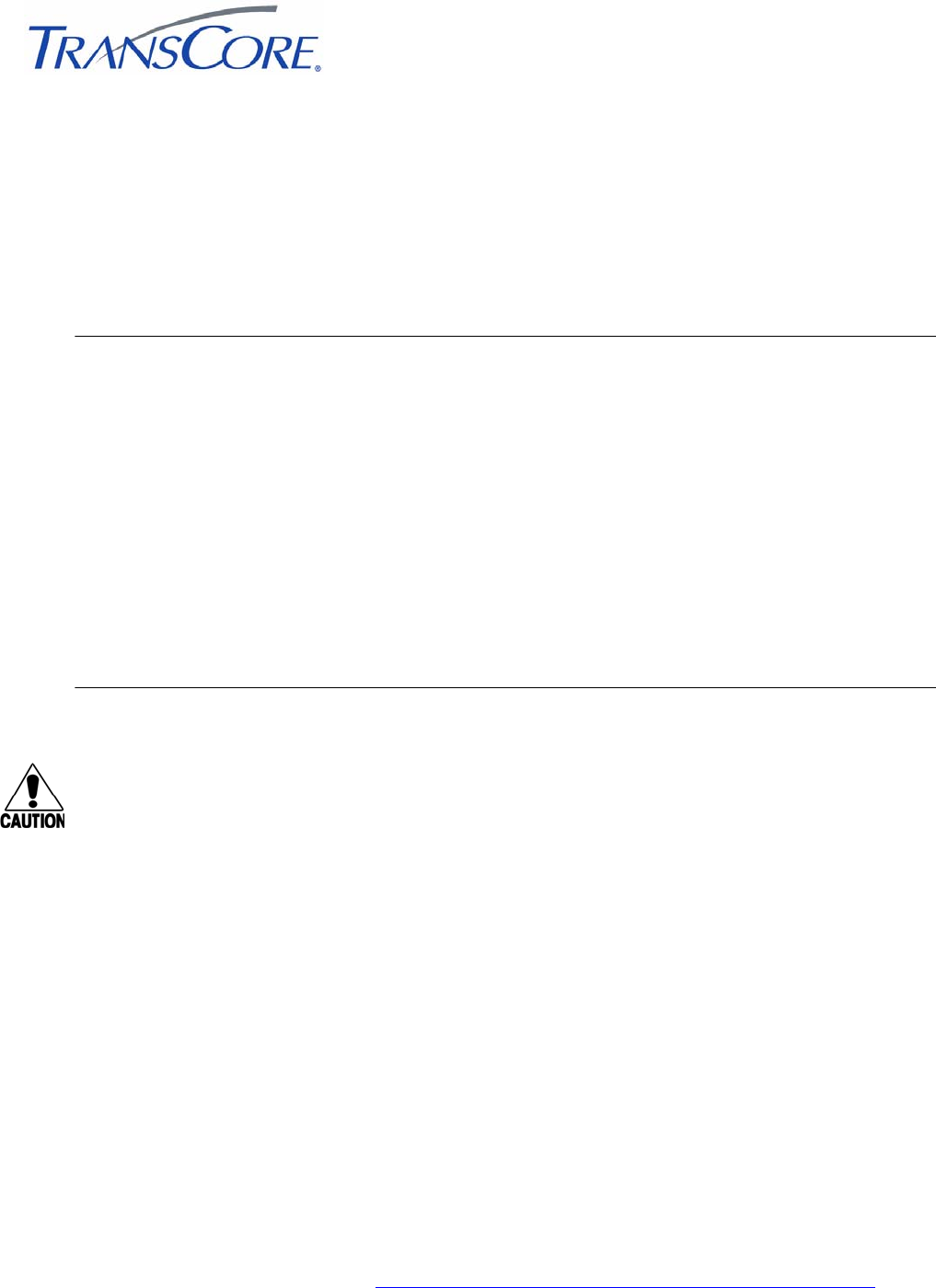
This document describes the procedures to set up and use an Encompass 1150 (E1150) Mobile Reader.
Required Supplies
You need the following additional materials and/or tools to complete the reader installation:
•Host PC using Windows (2000, XP, Vista, or 7) operating system with CD drive and at least one USB port
(either USB 1.0 or USB 2.0)
•Field Configuration Software (FCSW) CDROM
•USB communications cable provided with E1150
•Battery charger with power cable provided with E1150
•Test tag provided with E1150
Installing Field Configuration Software (FCSW)
Install the Field Configuration Software
Insert the FCSW CDROM into the host computer and follow the steps to load the software. The program installs a
shortcut icon for the software and a shortcut icon for the E1150 mobile reader instructions to the desktop.
CAUTION: Do not launch the field configuration software program at this time.
E1150 Setup
Note: The E1150 mobile reader is designed primarily for use in an office environment, but can be used outdoors in
a limited environment.
1. Place the E1150 on a flat surface.
2. Plug the power cord from the E1150 battery charger into the Charger port at the base of the E1150. Plug the
power cord into a standard 110V AC wall outlet. Allow the E1150 to fully charge. The green LED indicator
located on the charger will illuminate when the unit is ready for use. The E1150 unit receives its charging via
the dedicated charger connected through the Charger port. The unit cannot be charged through the USB port.
Note: The automatic charger shutoff allows for the E1150 to remain connected to the charger after completion of a
charge cycle.
3. Connect the USB data cable from the USB port at the base of the E1150 to one of the host computer's USB
ports. Allow the device driver to be detected and installed automatically.
If the device driver fails to automatically load, disconnect the E1150 from the host computer. Locate the
device driver setup executable file on the root directory of the field configuration software CDROM:
CDM20828_Setup.exe, or go to http://www.ftdichip.com/Drivers/CDM/CDM20828_Setup.exe to download
Encompass
®
1150
Mobile Reader
16-1150-002 REV A
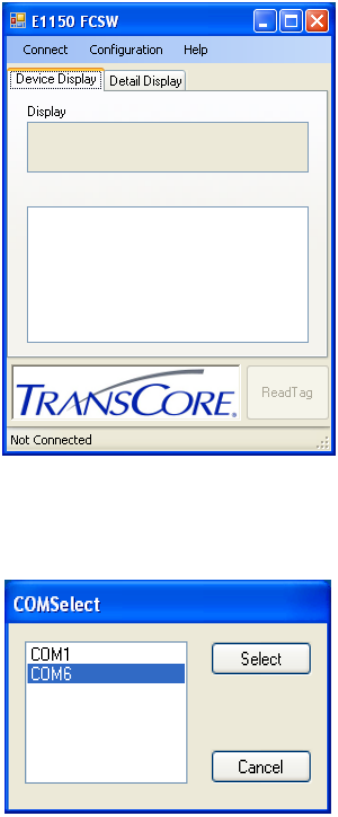
2
the driver from the FTDIchip website. Launch the CDM20828_Setup.exe file and allow it to automatically
install the necessary device driver. Reconnect the E1150 and allow it to be detected by the operating system.
Start the E1150 Field Configuration Software
1. Launch the field configuration software via the desktop shortcut icon.
2. The E1150 FCSW startup window will open (
Figure 1
). Click Connect. Click COM Port.
Figure 1 E1150 Field Configuration Software Startup Window
3. Select the associated COM port from the COMSelect window (
Figure 2
). Click CONNECT. Observe that
the connect status in the lower left corner of the window reads Connected.
Figure 2 COM Port Selection Window
4. To view the FCSW and E1150 Version information, click on Help and then About (
Figure 3
).
Note: The firmware version shown in
Figure 3
is for example only. Your version information may be different.
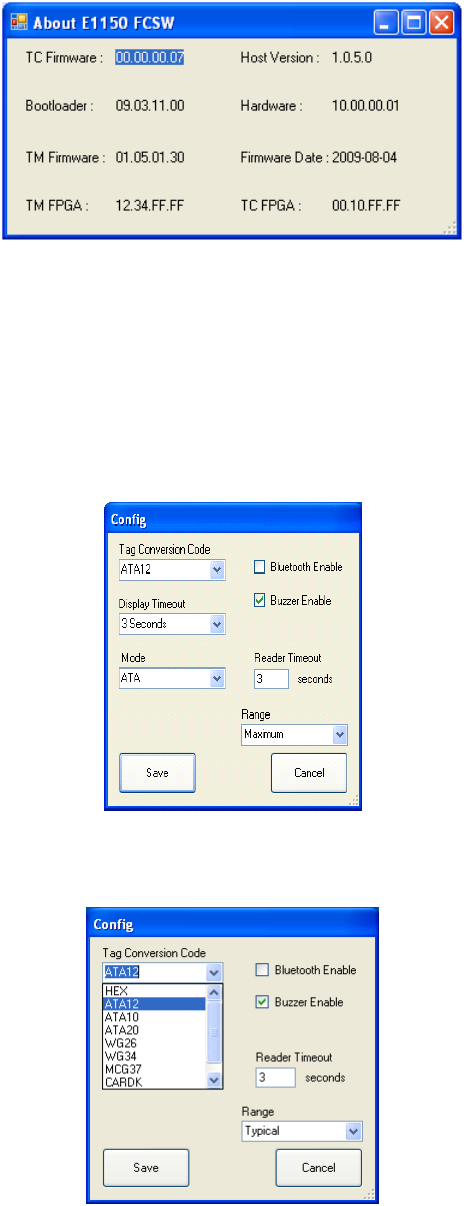
3
Figure 3 E1150 FCSW About Window
Configure the E1150 for Operation
Select the Configuration option in the FCSW window. Operation configuration parameters can be changed via
the Config window as shown in
Figure 4
. The configuration parameters are listed in the Tag Conversion Code
drop down menu as shown in
Figure 5
. Click Save after setting your options.
Figure 4 FCSW Default Configuration Window
.
Figure 5 FCSW Configuration Tag Conversion Code Choices
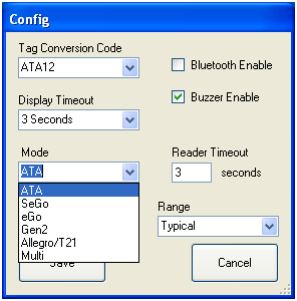
4
Here is a detailed description of the operational configuration parameters used in the Config window.
•The Tag Conversion Code is used to define how the E1150 will display the retrieved tag data. The default
parameter is ata12.
•The Display Timeout controls the amount of time available for displaying data. The default is 3 seconds.
Other times may be selected, but operational time will be significantly affected when the unit is running on
battery power.
•The Mode parameter is used to select the RFID protocol being used to read tags.
Figure 6
shows the Mode
drop down menu. The default is ATA Mode.
.
Figure 6 FCSW Configuration Mode Choices
•Multi Mode is used for reading tags from mixed tag populations such as FDOT. The Multi-Protocol Pair is
fixed to SeGo & Allegro/T21 and cannot be changed.
•Select Bluetooth Enable when tethering the reader to a Bluetooth connected device running a host
application. The default option is off.
•Select Buzzer Enable if you want to hear an audible signal on completion of a successful read. The default
option is on.
•The Reader Timeout configuration parameter should be set to 3 seconds for proper operation.
•The Range configuration parameter may be changed to conserve battery charge or optimize the read range
and will significantly affect operational time when battery powered. The default is Maximum. Select the
lowest possible range setting that works reliably with your tags and environment.
Reading Tags with the E1150
Place the Test Tag in front of the E1150 and push the Scan button located on the unit. Alternatively from the host
computer, click the Read Tag button on the E1150 FCSW window (
Figure 7
). Both the E1150 and the FCSW
display window will show the decoded tag data based on the protocol and tag conversion code configured in the
unit. If you prefer a more detailed representation of the tag data, select the Detail Display tab on the FCSW as
shown in
Figure 8
.

5
Figure 7 FCSW Read Tag Results - Device Display
Figure 8 FCSW ReadTag Results - Detail Display
Bluetooth Operation
With a user supplied USB Bluetooth® Adapter, a wireless Virtual COM port connection can be established with
the E1150. Follow the manufacturer’s instructions for installation of a Virtual COM port connection to the host
computer. Once a Bluetooth Virtual COM port connection is established with the Bluetooth dongle, the field
configuration software can be launched and used as before. The Bluetooth pairing number required for the
E1150 is 1234.
Note: The connection to the E1150 is established using a virtual COM port. It is necessary to ensure that only
one E1150 is enabled and within range of the host computer at any one time. Multiple Bluetooth connections are
not supported through the virtual COM port.
Disconnect the E1150
Note: It is important to exit the software on the host computer before disconnecting the reader from the system.
1. Exit the software on the host computer before you disconnect the reader. Click Disconnect in the E1150
FCSW Window. Observe that the status on the lower left corner of the window reads Not Connected.
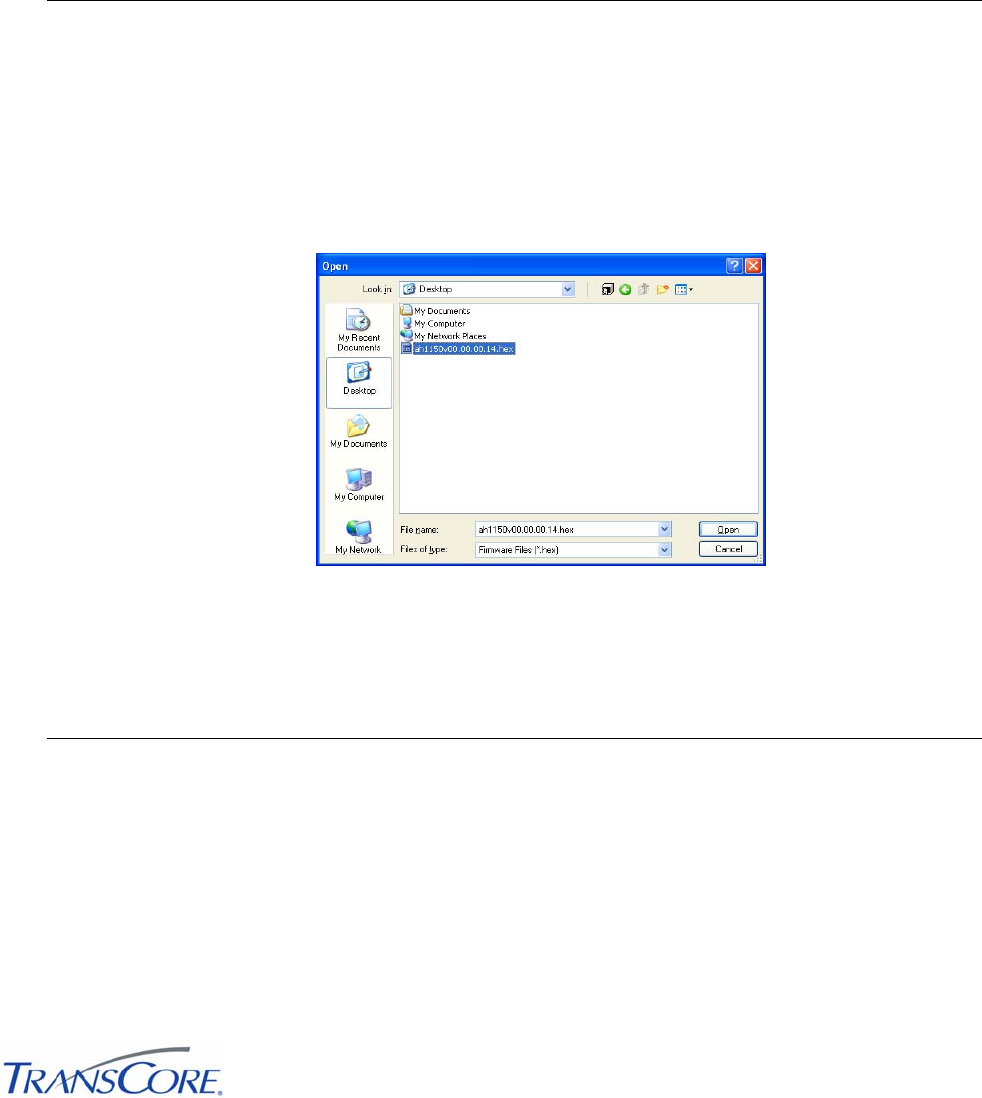
www.transcore.com
©2013. TransCore License, Ltd. All rights reserved. TRANSCORE and ENCOMPASS are registered trademarks and are used under license. All other trademarks are the
property of their respective owners. Contents are subject to change. Printed in the U.S.A.
SPECIFICATIONS
16-1150-002 REV A
2. Click the red X on the upper left corner of the window to exit the software.
3. Disconnect the E1150 reader from the host PC.
Firmware Update
Do not attempt to update the firmware unless you have obtained an official firmware upload file from Transcore.
Save this firmware download file to a known location on your computer such as the Windows desktop.
Firmware is updated via the Option tab under Firmware Upload.
Select Option > Firmware Upload.
A file explorer window will open. Navigate to the location of the firmware *.hex file (
Figure 9
).
Figure 9 Updating Firmware
Allow the process to complete. Exit the program.
Diagnostics
Should you encounter trouble when using the E1150 Mobile Reader, perform the following diagnostic steps.
1. Ensure that the unit is adequately charged or fully charge the unit.
2. Reposition the tag closer to the front area of the unit and try reading again.
3. Isolate the tag from other tags which might be interfering and try reading again.
If steps 1 and 2 do not correct the problem, uninstall then reinstall the host software on the host computer.
If steps 1 through 3 do not correct the problem, contact TransCore for further assistance.

Regulatory and Compliance
FCC RADIO FREQUENCY INTERFERENCE STATEMENT
47 CFR §15.105(a)
NOTE: This equipment has been tested and found to comply with the limits for a Class A digital
device, pursuant to part 15 of the FCC Rules. These limits are designed to provide reasonable
protection against harmful interference in a residential installation. This equipment generates,
uses and can radiate radio frequency (RF) energy and may cause harmful interference to radio
communications if not installed and used in accordance with the instruction manual. Operating
this equipment in a residential area is likely to cause harmful interference, in which case,
depending on the regulations in effect, the users may be required to correct the interference at
their own expense.
This equipment has been tested and found to comply with the limits for a Class A digital device,
pursuant to Part 15 of the FCC Rules, and Industry Canada license-exempt RSS standard(s).
Operation is subject to the following two conditions: (1) This device may not cause harmful
interference, and (2) this device must accept any interference received, including interference
that may cause undesired operation.
Le présent appareil est conforme aux CNR d'Industrie Canada applicables aux appareils radio
exempts de licence. L'exploitation est autorisée aux deux conditions suivantes : (1) l'appareil ne doit
pas produire de brouillage, et (2) l'utilisateur de l'appareil doit accepter tout brouillage
radioélectrique subi, même si le brouillage est susceptible d'en compromettre le fonctionnement.
NO UNAUTHORIZED MODIFICATIONS
47 CFR §15.21
CAUTION: The equipment may not be modified, altered, or changed in any way without
permission from TransCore, LP. Unauthorized modification may void the equipment
authorization from the FCC and will void the TransCore warranty.
TransCore License, Ltd.
USA